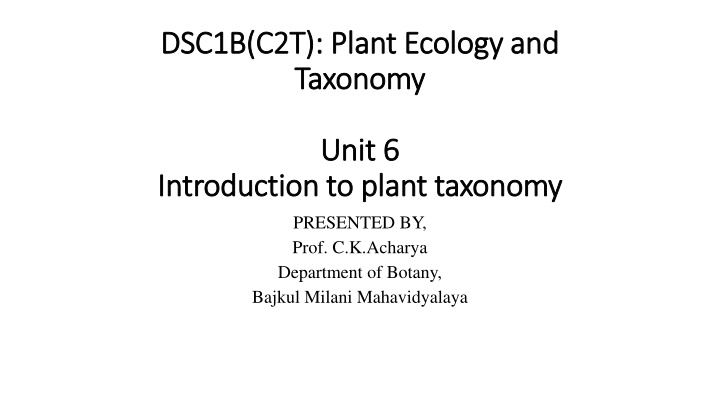
Introduction to Plant Taxonomy: History, Levels, and Binomial Nomenclature
Explore the fascinating world of plant taxonomy, from its rich history with Aristotle and Linnaeus to the modern classification systems like the five kingdom classification and binomial nomenclature. Learn about the seven levels of taxonomic classification and the rules of nomenclature in this informative guide presented by Professor C.K. Acharya.
Download Presentation

Please find below an Image/Link to download the presentation.
The content on the website is provided AS IS for your information and personal use only. It may not be sold, licensed, or shared on other websites without obtaining consent from the author. If you encounter any issues during the download, it is possible that the publisher has removed the file from their server.
You are allowed to download the files provided on this website for personal or commercial use, subject to the condition that they are used lawfully. All files are the property of their respective owners.
The content on the website is provided AS IS for your information and personal use only. It may not be sold, licensed, or shared on other websites without obtaining consent from the author.
E N D
Presentation Transcript
DSC1B(C2T): Plant Ecology and DSC1B(C2T): Plant Ecology and Taxonomy Taxonomy Unit 6 Unit 6 Introduction to plant taxonomy Introduction to plant taxonomy PRESENTED BY, Prof. C.K.Acharya Department of Botany, Bajkul Milani Mahavidyalaya
Taxonomy Taxonomy, in a broad sense the science of classification, but more strictly the classification of living and extinct organisms i.e., biological classification. The term is derived from the Greek taxis ( arrangement ) and nomos ( law ). Taxonomy is, therefore, the methodology and principles of systematic botany and zoology and sets up arrangements of the kinds of plants and animals in hierarchies of superior and subordinate groups. Among biologists the Linnaean system of binomial nomenclature, created by Swedishnaturalist Carolus Linnaeus in the 1750s,isinternationally accepted.
Identification Identification: Identification is "the practical side of taxonomy, the method of determining that a specific (organism) belongs to a recognized taxon." Or the method of nomenclature or naming is merely possible when the organism is described correctly and that we are known to what organism the name isattached to.
Classification History Of Classification Aristotle was the earliest who classified the organisms into two groups based on the presence or absenceofbloodin the organisms. Carolus Linnaeus who is also known as Father of the modern taxonomy classified the organisms on the basisofexternalfeaturesinto 6groupsasworms,insects,fishes, reptiles,birds,andquadruped. In 1969 RH Whittaker gave the 5 kingdom classification. This classification is the most relevant of all and is accepted. Later Carl Woese found that the archaebacteria were quite different from the eubacteria so they cannot be kept together. So he formed 3 domains above the level of kingdoms and gave the phylogenetic tree of evolutionofthesedomains.The threedomainsare-Bacteria,Eukarya,andArchaea.
Levels of classification Seven Levels of Taxonomic Classification Each level here is the taxon. DOMAIN KINGDOM PHYLUM CLASS ORDER GENUS SPECIES
Binomial Nomenclature . This system of nomenclature was given by Carl Linnaeus. Let us understand the system of binomial nomenclature by taking the example of mango. The scientific name of mango is given as Mangifera indica. Mangifera indicates the genus while indica represents a particular specie or specific epithet .
Rules of nomenclature Rules for the Binomial Taxonomy Nomenclature: Biological names are derived from Latin words irrespective of their origin and are written in italics. The first word in the biological name denotes the genus whereas the second word represents specific epithet. Both the genus and specific epithet are separately underlined or written in italics to show the Latin origin. Genus should start with a capital letter and specific epithet starts with a small letter. Name of the author is written after the specific epithet in the abbreviated form. It denotes the name of the person who described the species first Example: Mangifera indica Linn. In this Linn indicates the Biologist Linnaeus who first described the species of mango. It is very difficult to study each and every organism and remember its specifications. So we need to classify the species. This process of dividing species into certain groups is known as biological classification. Characterization, identification and classification are the basic processes of taxonomy nomenclature.













